American magazine: Human weight increases during the #superblue_moon


Throughout Monday night and into Tuesday morning, the people of Earth enjoyed watching a wonderful astronomical phenomenon, which is the “giant blue moon.”
The American astronomical magazine EarthSky indicated that the proximity of the Earth and the Moon during this period has a significant impact on the tides and the height of the oceans, and the gravitational interactions between the Moon, the Sun and the Earth during the “supermoon” phenomenon on August 19 affected the average human weight, as it increased. About 110 milligrams.
The magazine said: “The periodic approach of the Earth and the Moon during the “supermoon” has a major impact on the tides and height of the global ocean, but its impact on human weight is minimal. Thanks to the gravitational interactions between the Earth and the Moon, the weight of the average person during the current “supermoon” increased by about 73 mg, which is equivalent to 1/14 of the mass of a paper clip. Taking into account the influence of the Sun, the weight of the average person increased by 110 mg, which can Comparing it to the mass of 1/9 of a paper clip.”
However, the magazine pointed out that, unlike changes in human body weight, the effects of the “supermoon” effect on the global ocean can be seen with the naked eye, as the maximum proximity of the Moon and Earth increases the tides and increases their height by several centimeters. There is no strong impact on ships, ecosystems, or the appearance of the sea, but in some rare cases, tides increase the impact of storms and hurricanes on coastal areas.
It is noteworthy that the “supermoon” is a relatively common astronomical phenomenon, as the full moon coincides with the greatest approach between the Moon and the Earth. At these times, the moon appears to those viewing it on Earth as 14% larger and 30% brighter than usual.
There will be four more “supermoons” in 2024, the first of which occurred yesterday, and the next three will occur in the fall, September 18, October 17, and November 15. There will also be three “supermoons” in 2025 that will also occur in the fall months.
